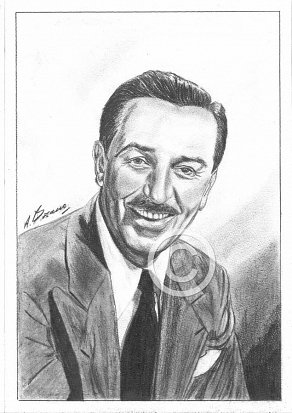Walt Disney
Pencil Portrait by Antonio Bosano.

Shopping Basket
The quality of the prints are at a much higher level compared to the image shown on the left.
Order
A3 Pencil Print-Price £45.00-Purchase
A4 Pencil Print-Price £30.00-Purchase
*Limited edition run of 250 prints only*
All Pencil Prints are printed on the finest Bockingford Somerset Velvet 255 gsm paper.
P&P is not included in the above prices.

Recommended reading
Walt Disney - An American Original (Bob Thomas) 1976
Authorised implies sanitised, yet Thomas succeeds in achieving a balanced portrait of the entertainer, never shirking the responsibility of recounting the more controversial aspects of his life – political beliefs and affiliations, conflicts with organized labour before WWII, his growing conservatism – whilst celebrating those unique achievements so indelibly associated with him – the creation of his animated films, the development of Disneyland, and his cultural dominance of childhood in the post war era.
Sanctioned by the family, Thomas had full access to the Disney records, and he provides what every major historical figure needs: a book that gets the facts straight, so that other biographers and historians can then argue correctly about interpretations.
Thomas recounts how Disney envisaged his theme park as something quite ‘organic,’ a magical environment that would mushroom and adapt to changing customer tastes and requirements. He would have to live with the imperfections in his films after their theatrical release, but Disneyland could be constantly honed and refined.


Comments
Last update : 28/9/15
Walt Disney was the impresario of a troop of young women, most of them under 25—a casting director’s dream of all-American acolytes—who made the screen light up, not with feathered swan dives or the perfect tip-tap of a patent-leather heel, but by making water shimmer or a tail wag just so. It was a job complicated by his unrelenting perfectionism — ‘Jiminy Cricket’ requiring 27 different colors—but reducible to a simple imperative of the time: ever nimble but never showy, their job was to make what the men did look good.
Whilst roughly 100 of his male employees were responsible for bringing his initial vision to the big screen, it was the young women – neither downtrodden factory workers nor madcap flappers who jumped into fountain – who were caught in the sand trap of repetitive, highly precise work where eyes strained, waistlines shrank, and some even fainted. Yet Disney knew they loved what they did and wanted to be the best. Understanding their motivation was key to extracting 85 hours a week of focused concentration from them for the princely sum of $16!